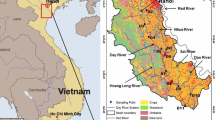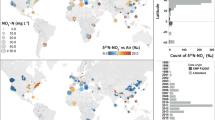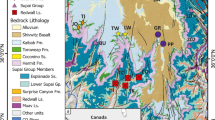Abstract
Isotope analyses of nitrate and algae were used to gain better understanding of sources of nitrate to Florida’s karst springs and processes affecting nitrate in the Floridan aquifer at multiple scales. In wet years, δ15N and δ18O of nitrate ranged from +3 to +9‰ in headwater springs in north Florida, indicating nitrification of soil ammonium as the dominant source. With below normal rainfall, the δ15N and δ18O of nitrate were higher in almost all springs (reaching +20.2 and +15.3‰, respectively) and were negatively correlated with dissolved oxygen. In springs with values of δ15N-NO3 and δ18O-NO3 greater than +10‰, nitrate concentrations declined 40–50% in dry years and variations in the δ15N and δ18O of nitrate were consistent with the effects of denitrification. Modeling of the aquifer as a closed system yielded in situ fractionation caused by denitrification of 9 and 18‰ for Δ18O and Δ15N, respectively. We observed no strong evidence for local sources of nitrate along spring runs; concentrations declined downstream (0.42–3.3 μmol-NO3 L−1 per km) and the isotopic dynamics of algae and nitrate indicated a closed system. Correlation between the δ15N composition of nitrate and algae was observed at regional and spring-run scales, but the relationship was complicated by varying isotopic fractionation factors associated with nitrate uptake (Δ ranged from 2 to 13‰). Our study demonstrates that nitrate inputs to Florida’s springs are derived predominantly from non-point sources and that denitrification is detectable in aquifer waters with relatively long residence time (i.e., matrix flow).







Similar content being viewed by others
References
Albertin A (2009) Nutrient dynamics in Florida Springs and relationships to algal blooms. Dissertation, University of Florida
Anderson JM (1976) An ignition method for the determination of total phosphorus in lake sediments. Water Res 10:329–331
Aravena R, Robertson WD (1998) Use of multiple isotope tracers to evaluate denitrification in ground water: Study of nitrate from a large-flux septic system plume. Ground Water 36:975–982
Bacchus ST, Barile PJ (2005) Discriminating sources and flowpaths of anthropogenic nitrogen discharges to Florida springs, streams and lakes. Env Eng Geosci 11:347–369
Böttcher J, Strebel O, Voerkelius S, Schmidt HL (1990) Using isotope fractionation of nitrate nitrogen and nitrate oxygen for evaluation of microbial denitrification in a sandy aquifer. J Hydrol 114:413–424
Casciotti KL, Sigman DM, Hastings MG, Böhlke JK, Hilkert A (2002) Measurement of the oxygen isotopic composition of nitrate in seawater and freshwater using the denitrifier method. Anal Chem 74:4905–4912
Chelette AR, Pratt TR, Katz BG (2002) Nitrate loading as an indicator of nonpoint source pollution in the lower St. Marks–Wakulla Rivers watershed. Northwest Florida Water Management District Water Resources Special Report 02-1, Havana
Chen DJZ, MacQuarrie KTB (2005) Correlation of δ15N and δ18O in NO3 − during denitrification in groundwater. J Environ Eng Sci 4:221–226
Cohen MJ (2008) Springshed nutrient loading, transport and transformations. In: Brown MT (ed) Summary and synthesis of available literature on the effects of nutrients on spring organisms and systems. University of Florida Water Institute, Gainesville
Dahnke K, Bahlmann E, Emeis K (2008) A nitrate sink in estuaries? An assessment by means of stable nitrate isotopes in the Elbe estuary. Limnol Oceanogr 53:1504–1511
De Brabandere L, Frazer TK, Montoya JP (2007) Stable nitrogen isotope ratios of macrophytes and associated periphyton along a nitrate gradient in two subtropical, spring-fed streams. Freshw Biol 52:1564–1575
Derse E, Knee KL, Wankel SD, Kendall C, Berg CJ, Paytan A (2007) Identifying sources of nitrogen to Hanalei Bay, Kauai, utilizing the nitrogen isotope signature of macroalgae. Environ Sci Technol 41:5217–5223
Dietrich PG, Herbert D (1997) Regional discharge of a Triassic artesian karst aquifer: Mixing and age of spring waters in the Thuringian basin, Germany, estimated by isotope methods. In: Gunay G, Johnson AI (eds) Karst waters and environmental impacts. AA Balkema, Rotterdam
Durka W, Schulze ED, Gebauer G, Voerkelius S (1994) Effects of forest decline on uptake and leaching of deposited nitrate determined from N-15 and O-18 measurements. Nature 372:765–767
Einsiedl F, Mayer B (2006) Hydrodynamic and microbial processes controlling nitrate in a fissured-porous karst aquifer of the Franconian Alb, Southern Germany. Environ Sci Technol 40:6697–6702
Einsiedl F, Maloszewski P, Stichler W (2005) Estimation of denitrification potential in a karst aquifer using the N-15 and O-18 isotopes of NO3 −. Biogeochemistry 72:67–86
Fogel ML, Cifuentes LA (1993) Isotope fractionation during primary production. In: Engel MH, Macko SA (eds) Organic geochemistry. Plenum Press, New York, pp 73–98
Fry B (2006) Stable isotope ecology. Springer, New York
Fukada T, Hiscock KM, Dennis PF (2004) A dual-isotope approach to the nitrogen hydrochemistry of an urban aquifer. Appl Geochem 19:709–719
Granger J, Sigman DM, Needoba JA, Harrison PJ (2004) Coupled nitrogen and oxygen isotope fractionation of nitrate during assimilation by cultures of marine phytoplankton. Limnol Oceanogr 49:1763–1773
Happell JD, Opsahl S, Zafer T, Chanton JP (2006) Apparent CFC and 3H/3He age differences in water from Floridan Aquifer springs. J Hydrol 319:410–426
Hiers JK, Mitchell RJ, Boring LR, Hendricks JJ, Wyatt R (2003) Legumes native to longleaf pine savannas exhibit capacity for high N2-fixation rates and negligible impacts due to timing of fire. New Phytol 157:327–338
Hornsby HD, Ceryak R (1999) Springs of the Suwanee River Basin in Florida. Suwanee River Water Management, Live Oak
Katz BG (2004) Sources of nitrate contamination and age of water in large karstic springs of Florida. Environ Geol 46:689–706
Katz BG, Griffin DW (2008) Using chemical and microbiological indicators to track the impacts from the land application of treated municipal wastewater and other sources on groundwater quality in a karstic springs basin. Environ Geol 55:801–821
Katz BG, Hornsby HD, Böhlke JF, Mokray MF (1999) Sources and chronology of nitrate contamination in spring waters, Suwannee River Basin, Florida. US Geological Survey Report 99-4252, Tallahassee
Katz BG, Böhlke JK, Hornsby HD (2001) Timescales for nitrate contamination of spring waters, northern Florida, USA. Chem Geol 179:167–186
Katz BG, Griffin DW, Davis JH (2008) Groundwater quality impacts from the land application of treated municipal wastewater in a large karstic spring basin: chemical and microbiological indicators. Sci Total Environ 407:2872–2886
Kendall C (1998) Tracing nitrogen sources and cycling in catchments. In: Kendall C, McDonnell JJ (eds) Isotope tracers in catchment hydrology. Elsevier, Lausanne
Kendall C, Elliott EM, Wankel SD (2007) Tracing anthropogenic inputs of nitrogen to ecosystems. In: Lajtha K, Michener RH (eds) Stable isotopes in ecology and environmental science, 2nd edn. Blackwell, Oxford
Knöller K, Vogt C, Haupt M, Feisthauer S, Richnow HH (2011) Experimental investigation of nitrogen and oxygen fractionation in nitrate and nitrite during denitrification. Biogeochemistry. doi:10.1007/s10533-010-9483-9
Kreitler CW (1979) Nitrogen-isotope ratio studies of soils and groundwater nitrate from alluvial fan aquifers in Texas. J Hydrol 42:147–170
Martin JB, Dean RW (2001) Exchange of water between conduits and matrix in the Floridan aquifer. Chem Geol 179:145–165
Martin JB, Gordon SL (2000) Surface and groundwater mixing, flowpaths, and temporal variations in chemical composition of karst springs. In: Sasowsky ID, Wickes CM (eds) Groundwater flow and contaminant transport in carbonate aquifers. AA Balkema, Rotterdam, pp 65–92
Munch DA, Toth DJ, Huang, C, Davis JB, Fortich CM, Osburn WL, Phlips EJ, Quinlan EL, Allen MS, Woods MJ, Cooney P, Knight RL, Clarke RA, Knight SL (2006) Fifty year retrospective study of the ecology of Silver Springs, Florida. Special Publication SJ2007-SPA. St. Johns River Water Management District, Palatka
Panno SV, Hackley KC, Hwang HH, Kelly WR (2001) Determination of the sources of nitrate contamination in karst springs using isotopic and chemical indicators. Chem Geol 179:113–128
Pauwels H, Foucher JC, Kloppmann W (2000) Denitrification and mixing in a schist aquifer: influence on water chemistry and isotopes. Chem Geol 168:307–324
Pellerin BA, Downing BD, Kendall C, Dahlgren RA, Kraus TEC, Saraceno J, Spencer RGM, Bergamaschi BA (2009) Assessing the sources and magnitude of diurnal nitrate variability in the San Joaquin River (California) with an in situ optical nitrate sensor and dual nitrate isotopes. Freshw Biol 54:376–387
Pinowska A, Stevenson RJ, Albertin A, Sickman JO, Anderson M (2007) Integrated interpretation of survey for determining nutrient thresholds for macroalgae in Florida springs: macroalgal relationships to water, sediment and macroalgae nutrients, diatom indicators and land use. Florida Department of Environmental Protection, Tallahassee
Plummer LN, Sprinkle CL (2001) Radiocarbon dating of dissolved inorganic carbon in groundwater from confined portions of the Upper Floridan aquifer, Florida, USA. Hydrogeol J 9:127–150
Rhue RD, Harris WG, Nair VD (2006) A retardation-based model for phosphorus transport in sandy soil. Soil Sci 171:293–304
Ritorto M, Screaton EJ, Martin JB, Moore PJ (2009) Relative importance and chemical effects of diffuse and focused recharge in an eogenetic karst aquifer: an example from the unconfined upper Floridan aquifer, USA. Hydrogeol J 17:1687–1698
Scott TM, Means GH, Meegan RP, Means RC, Upchurch SB, Copeland RE, Jones J, Roberts T, Willet A (2004) Springs of Florida. Bulletin No. 66, Florida Geological Survey, Tallahassee
Sickman JO, Albertin AR, Anderson MW, Pinowska A, Stevenson RJ (2009) A comparison of internal and external supply of nutrients to algal mats in two first magnitude springs in Florida. J Aquat Plant Manag 47:135–144
Sigman DM, Casciotti KL, Andreani M, Barford C, Galanter M, Böhlke JK (2001) A bacterial method for the nitrogen isotopic analysis of nitrate in seawater and freshwater. Anal Chem 73:4145–4153
Sigman DM, Granger J, DiFiore PJ, Lehmann MM, Ho R, Cane G, van Green A (2005) Coupled nitrogen and oxygen isotope measurements of nitrate along the eastern North Pacific margin. Global Biogeochem Cycles 19:GB4022. doi:10.1029/2005GB002458
Southeast Regional Climate Center (2010) Historical Climate Summaries Database. http://www.sercc.com/climateinfo/historical/historical.html. Accessed 22 Dec 2010
Stevenson RJ, Pinowska A, Wang Y (2004) Ecological condition of algae and nutrients in Florida Springs. Florida Department of Environmental Protection, Tallahassee
Strong WA (2004) Temporal water chemistry trends within individual springs and within a population of Florida Springs. Thesis, University of Florida, Gainesville
Van Breemen N, Boyer EW, Goodale CL, Jaworski NA, Paustian K, Seitzinger S, Latjha LK, Mayer B, Van Dam D, Howarth RW, Nadelhoffer KJ, Billen G (2002) Where did all the N go? Fate of N inputs to large watershed in the northeastern USA. Biogeochemistry 57(58):267–293
Vasques GM, Grunwald S, Comerford NB, Sickman JO (2010) Regional modeling of soil carbon at multiple depths within a subtropical watershed. Geoderma 156:326–336
Wankel SD, Kendall C, Paytan A (2009) Using nitrate dual isotopic composition (delta N-15 and delta O-18) as a tool for exploring sources and cycling of nitrate in an estuarine system: Elkhorn Slough, California. J Geophy Res Biogeo 114:G01011
Wilson WL, Skiles WC (1988) Aquifer characterization by quantitative dye tracing at Ginnie Spring, Northern Florida. The Association of Groundwater Scientists and Engineers, Dublin
Acknowledgments
We thank Martin Anderson, Mi Youn Ahn, Scott Fulbright, Delores Lucero, Francisco Alvarado, Mayana Anderson, Eric Jorczak, Alyson Dagang, Will Vicars, Yu Wang, Gavin Wilson, Yubao Cao and Xiaowei Gu for assistance with field surveys and laboratory analyses. We thank Russ Frydenborg and Denise Miller for their support of the project. We also thank Dr. Brian Fry for insightful comments on the study. Funding was provided by the Florida Department of Environmental Protection and the University of Florida.
Author information
Authors and Affiliations
Corresponding author
Electronic supplementary material
Below is the link to the electronic supplementary material.
Rights and permissions
About this article
Cite this article
Albertin, A.R., Sickman, J.O., Pinowska, A. et al. Identification of nitrogen sources and transformations within karst springs using isotope tracers of nitrogen. Biogeochemistry 108, 219–232 (2012). https://doi.org/10.1007/s10533-011-9592-0
Received:
Accepted:
Published:
Issue Date:
DOI: https://doi.org/10.1007/s10533-011-9592-0




